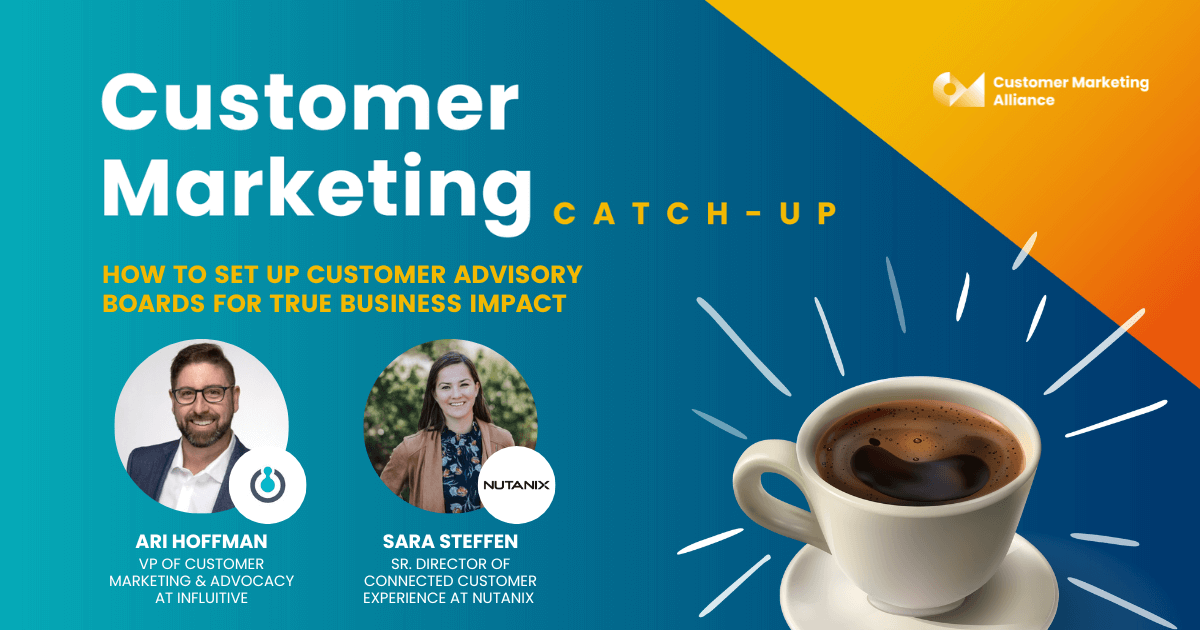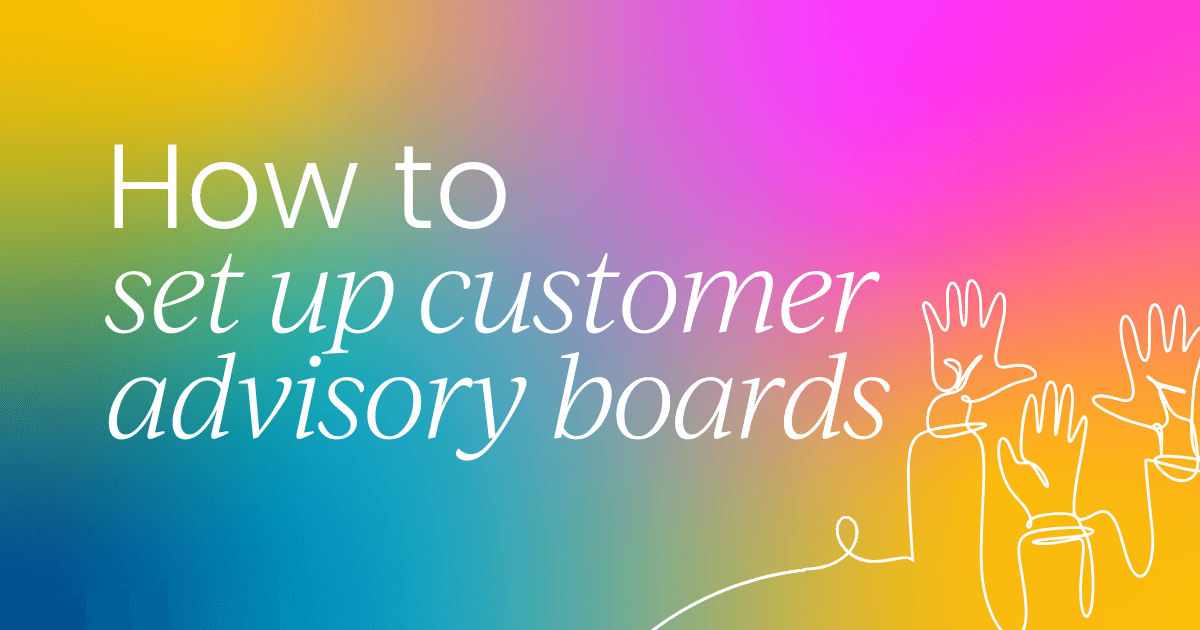As customer-led growth becomes a core pillar of business strategy, customer advisory boards (CABs) have evolved from feedback forums into powerful engines for strategic alignment and innovation.
At Nutanix, we’ve seen firsthand how a well-structured CAB not only surfaces valuable insights but also strengthens executive relationships, influences product direction, and builds a deeper sense of customer loyalty.
When you pair intentional cohort design with active follow-through and a clear action process, advisory boards become more than conversations, they become catalysts for measurable business impact.

How we use customer advisory boards for strategic decision-making
At Nutanix, we use our CABs as a core part of our customer decision-making process. These boards are about more than just gathering feedback, they’re a strategic forum where we bring together the right people to have meaningful conversations that can influence our business decisions, shape our product roadmap, and steer our overall strategy.
We think carefully about who’s in the room (whether it’s a virtual or in-person setting) and how we act on the feedback we hear. The goal is always to make sure that our customers feel heard and that their insights lead to real, tangible action on our part.
The most important element: Who’s in the room
The single most important factor in building an effective advisory board is determining who should be on it. At Nutanix, our advisory boards are made up exclusively of customers, but we ensure there’s diversity in industry representation and seniority.
We also design each board around a specific level of seniority to ensure peer-to-peer conversations.
For example, if it's a C-level advisory board, all members should be C-level executives. If it’s a board for VPs or Senior Directors, we keep the conversations and participants at that level. This structure not only shapes the kind of dialogue that takes place, but also determines which Nutanix executives join those discussions.
Ultimately, we want a mix of voices in the room. That means different industries, different tenures, and different perspectives, because those differences enrich the dialogue and make the feedback more powerful.
Tailoring topics to the level of the board
We think of our advisory boards as a pyramid, with executive advisory boards at the top. These are made up of C-level customers alongside our own company’s C-level leaders. At that level, the focus is on business strategy and long-term vision.
We also use this forum to test ideas around our brand. For instance, when we rebranded in the spring, we brought it to our Executive Advisory Board before launching anything externally. We asked them: does this direction resonate with you? Does it feel like Nutanix? Their insights helped validate our direction before we went public with it.
Engaged executives create value
It’s not enough to invite someone simply because they have a certain title. We look for executives who are engaged – those who already understand and are invested in our brand and ecosystem.
This could include both long-term customers who’ve grown with us and newer customers who are fully deployed and already seeing ROI from our solutions.
This mix is essential. Long-term customers can speak to the evolution of our relationship and the growth they’ve experienced. Meanwhile, newer customers bring a fresh perspective and aren’t anchored by prior experiences. That balance allows for rich, layered conversations.
The magic happens when they talk to each other
One of the most powerful outcomes is when our customers talk directly to one another. A newer executive might ask questions about the customer journey, and a long-time customer can share how they started and what they’ve added over the years.
That peer-to-peer exchange is where the real magic happens. It’s those moments, where we just sit back and listen, that provide the deepest insights and the greatest value.

Engaging the decision makers
Our customer advisory board at the decision-maker level typically includes senior directors and VPs. This is where we start to get more product-focused. While there’s still discussion around overall business strategy, these sessions often lean into product roadmap, solution direction, and how our offerings are evolving.
This level of conversation requires balance. Some participants will want to go deep into the weeds, while others are more focused on strategic alignment. That’s why having a strong moderator or board chair is critical.
They help keep discussions productive, steer them away from overly technical detours, and ensure we stay aligned with the goals of the session. If a conversation starts to get too niche or technical, you risk losing a portion of the audience, so managing that dynamic well is key.
Listening to the people closest to the product
We also run a global Technical Advisory Board made up of about 60 IT admins and systems engineers – the people who use our products every day. These are incredibly technical conversations, and they’re led by our product marketing team.
In this setting, we go deep into individual products or solutions. Meetings are run virtually due to the size of the group, and they focus heavily on actionable feedback. As with all our boards, when feedback is shared that we can act on, we make sure to follow through.
We’ve also historically done smaller, regional in-person technical advisory meetups, but we likely won’t go back to flying in the full group for a single event.
However, if we already have a customer event or summit planned, we might organize a breakout session as part of that larger gathering. That hybrid approach allows us to stay efficient while still creating space for deeper engagement.
How to select participants for each board
The selection process for each board varies depending on the group. With the Technical Advisory Board, we’re less stringent, it’s a broader group, and we want as many relevant voices as possible.
But when it comes to our executive advisory board, it’s a much more curated experience. We typically cap it at around 15 C-level participants, which means every seat counts. With over 24,000 customers globally, the selection process is highly strategic. We look at things like logo recognition, total spend, pipeline opportunities, and geographic and industry mix.
Currently, we’re in the process of refreshing that board, so we’re re-evaluating who to invite. We created a shortlist of target participants, then vetted that list with our sales leadership, executive team, and even our CEO. It’s a collective effort to ensure we’re getting the right people into the room.
The same strategic lens applies to our CAB. We look at a variety of factors, including spend, open pipeline, and brand recognition. If two customers have similar spend levels, but one is a globally recognized brand, we’re likely to prioritize that invite, especially since we want to share their story externally at some point.
Integrating advisory boards with events
One strategy we’ve found successful is pairing advisory board meetings with larger customer events. For example, at our conference in Chicago, we brought our CAB members together for a focused two-and-a-half-hour session with our executives. Then, they stayed for the full event.
It was a win-win: our board members were already onsite, our executives were present, and we could maximize the time for both structured feedback and informal conversations. It’s an efficient way to deepen engagement without requiring additional travel or scheduling.
Turning advocates into advisory voices
One idea we've experimented with is bringing together our top customer advocates at the same time as our executive advisory board. While they attend separate sessions during the day, we plan overlapping social experiences, like a shared happy hour or dinner. For example, we’ll seat advocates next to executives to spark cross-functional conversations.
These informal interactions often create some of the most valuable exchanges. Executives get to hear directly from the people who are hands-on with our technology every day. And sometimes, hearing feedback from an external advocate carries more weight than internal reports.
It opens minds, builds empathy, and reinforces why the product matters across all levels of the customer organization.
How to keep CAB members engaged long term
To keep our advisory board members engaged, we check in every year. We ask how they’re feeling about their participation and whether they’d like to continue for another year. Our retention rate is incredibly high, which tells us the experience is resonating.
Before each meeting, we send a survey asking for input on agenda topics and which executives they’d like to hear from. Afterward, we do a follow-up survey to understand what worked, what didn’t, and what we should do differently. We want our members to feel like the agenda is built with them, not for them.
Beyond the meetings themselves, we try to create VIP experiences, whether that's special room drops, holiday gifts, or personal touches like a handwritten note from our CEO. When someone retires, we don’t just say thank you, we send something thoughtful to mark the occasion. These gestures are part of how we show they’re not just contributors, they’re part of our tribe.
We also ensure they have a direct line to our executive team. That access is a huge value-add. I’ve seen board members use it mid-deal or even during urgent support issues. It gives them a level of advocacy most customers don’t have.
How to make sure feedback turns into action
We’ve all seen what happens when feedback goes into a black hole, it’s incredibly frustrating for customers and can even turn promoters into detractors. We’re committed to making sure that doesn’t happen.
After every advisory board meeting, we go through the transcript line by line and identify every single piece of actionable feedback.
We create a tracker that notes who said what, what the request or comment was, and who inside Nutanix owns the follow-up. That might be a product manager, an executive, or an account manager, but someone is accountable.
Sometimes, this means scheduling one-off meetings to dig deeper into feedback. Other times, it’s a broader issue that gets routed into our product roadmap. Either way, we close the loop.
We also ensure our account teams are in the loop, especially if they weren’t in the room during the session. We'll flag specific points so they’re prepared going into their next conversation with that customer and can coordinate with internal teams on how best to respond.
At the next advisory meeting, we summarize the key themes we heard last time and what we’ve done about them. We won’t walk through all 50 action items line by line, but we do make it clear that follow-up has happened.
If someone asks for a meeting, we’ve booked it. If we heard consistent feedback on a topic, we’ve either acted or are in the process of acting. That follow-up builds trust and keeps the dialogue going.
Making customers feel like they truly matter
Ultimately, it all comes down to creating a sense of ownership. When customers see their input shaping your strategy or product roadmap, they feel connected in a much deeper way. That kind of engagement is what turns one-time contributors into lifelong champions.
We don’t just want feedback. We want partnership. And that starts with listening carefully, acting thoughtfully, and always following through.


 8 min read
8 min read
 Follow us on LinkedIn
Follow us on LinkedIn





